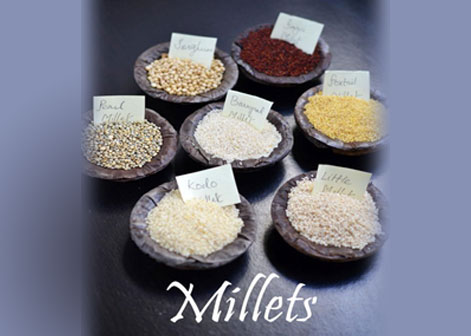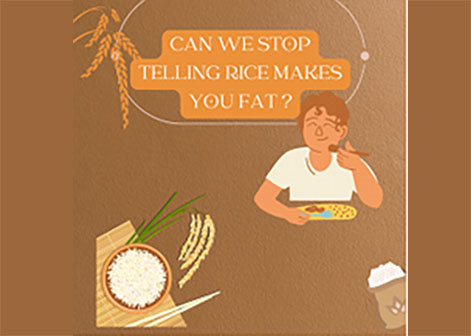
Why traditional foods are very important?
March 5, 2022
Unknown health benefits of palm jaggery
March 5, 2022Millets are cereal grain that belongs to the Poaceae family, commonly known as the grass family. They are a group of highly variable small seeded grasses, widely grown around the world as cereal crops or grains for human food and as fodder. It has multiple advantages over other crops including drought and pest resistance. Its also able to survive in harsh environments and less fertile soil.

Although all millet varieties belong to Poaceae family, they differ in colour, appearance and species. The different types of millets are:
- Pearl millet
- Kodo millet
- Foxtail millet
- Sorghum
- Banyard millet
- Little millet
- Proso millet
- Finger millet
Nutritional value of millets
Over the past years, traditional millets are considered one of the healthy food revolutions. Millets are considered nutritious because it contains unique rich content of nutrients. Every 100 grams of millets contain 378 calories of energy.
Total fats – 4.2 grams
Saturated fat – 0.7 grams
Carbohydrate – 73 grams
Dietary fibre – 8.5 grams
Protein – 11grams
Folate – 85 mcg
Niacin – 4.72 mcg
Pantothenic acid – 0.848 mg
Riboflavin – 0.290 mg
Thiamine – 0.421 mg
Vitamin b6 – 0.384 mg
Vitamin E – 0.05 mg
Tocopherol alpha – 0.05 mg
Vitamin K – 0.9 mg
Calcium – 1 % of DV
Iron – 17 % of DV
Copper - 38 % of DV
Magnesium – 28% of DV
Manganese – 82 % of DV
Phosphorous – 28% of DV
Potassium – 4 % of DV
Selenium – 4 % of DV
Zinc – 11 % of DV
Health benefits of traditional millets
- Good for heart patients
- Helps in weightloss
- Reduces the risk of colon cancer and breast cancer
- Decreases blood pressure
- Helps in control of celiac disease
- Controls diabetes
- Good source of antioxidants
- Helps in slowing down muscle degradation
Consumption of millets everyday helps decrease the triglyceride levels in the body. Its a natural blood thinner thereby helps in prevention of sunstroke and coronary artery disorder
Millets contain tryptophan, an amino acid that lowers the appetite and helps in managing weight. It digests at a slower rate and keeps the stomach full for a longer period of time. Millets are high in fibre and satiate hunger quickly, preventing from overeating. People who wants to loose weight should incorporate millets at least in one of their main meals.
Millets contains both fibres and phytonutrients, the combination of which is believed to reduce the risk of developing colon cancer. Lignan, a phytonutrient present in millets is converted into mammalian lignan in the intestine that protects from breast caner. In fact, the consumption of millet can lower the risk of developing breast cancer by 50%.
Magnesium present in the millets relaxes the muscles that line the inside of the arterial wall, which in turn helps to reduce the blood pressure. Millets also reduces the severity of asthma and frequency of migraines.
Celiac is a disease that damages the small intestine and interferes with the absorption of nutrients from food. People who suffer from this disease cannot tolerate gluten. Consumption of millets helps in controlling the celiac disease by repairing the intestinal wall thereby helping in proper absorption of nutrients.
Millets are low GI foods. Low GI (glycaemic index) foods are foods that are digested at a steady rate and releases the glucose in blood slowly thereby keeping the blood sugar level at a constant ratio. Millets increases the insulin sensitivity for people suffering from diabetes and also helps to control the sugar levels for non-diabetics.
The high amount of antioxidants present in millets fights free radicals present in the body which slows down the aging process.
Millets are high protein grains and contain lysine, an amino acid which slows down the muscle degradation process and helps to build leaner muscles.
- Aids with insomnia
- Helps in relieving menstrual cramps
- Aids in breast milk production
- Improves skin elasticity
Tryptophan in millet raises the serotonin levels in the body which helps in reducing stress. A cup of millet porridge every night can help to get sound and peaceful sleep.
Because of high levels of magnesium in millets, its a great food for women who suffer from unbearable pain and cramps during their menstrual cycle. Also, its rich in folate helps in regulation of RBC’s loss during menstruation.
Pregnant and lactating women are advised to consume millet porridge to increase the production of breastmilk. This enables the mother to feed the child for a longer period of time.
Millets are rich in aminocids called L-Lysine and L-proline. These helps to create collagen in the body, a substance which gives structure to skin’s tissues thus improving skin elasticity and making it less prone to wrinkles.




